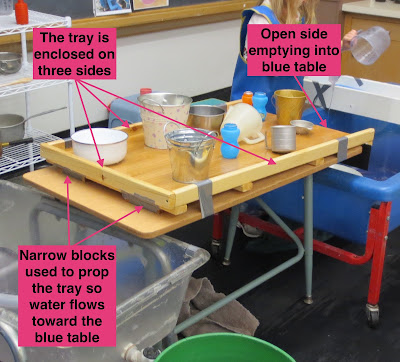 On the left, the children piled their Moon Sand creations on the tray. On the right, the children collected swamp water in the tray. Whether they were working with sand or water, the wooden tray invited the children to work on a second level above the bottom of the table. (See axiom #3 on the right hand column of the blog.)
On the left, the children piled their Moon Sand creations on the tray. On the right, the children collected swamp water in the tray. Whether they were working with sand or water, the wooden tray invited the children to work on a second level above the bottom of the table. (See axiom #3 on the right hand column of the blog.)Five years ago, I built another wooden tray. This one was the size of a table top. In fact, when I set it up, I set it up on a table between two sensory tables. The idea was to create a work space on a second level for the children that would allow for a lot of pouring and mixing without having to worry about spills.
The tray was made from a thin sheet of wood paneling that was attached to a rudimentary frame of 1” x 2” pine boards. The whole apparatus was sanded smooth and covered in polyurethane so it could be used with water. The tray was enclosed on three sides and open on a fourth side. It was propped slightly on one end so any water that spilled drained down the tray into the blue table.
There was one more important addition to the tray: a plastic flap to direct the water coming off of the tray into the the table. Without the flap, the water clung to the bottom of the apparatus and splashed on the floor.
One of the nice features of this apparatus was its size. It could accommodate multiple children and their operations at the same time. In the video below, the children were all cooking. The first one says she was making soup. The second says she was making something from three different pots that contained M&M's and chocolate. The first child liked the sound of that so she switched to making chocolate, lots of chocolate. After hearing this exchange between the other two, the third child declared she was making noodles.
Cooking club from Thomas Bedard on Vimeo.
Not only did this apparatus foster all kinds of social interaction, it also fostered specific kinds of motor skill development. In the video below, the child was filling the ice cube tray with a plastic syringe. To do that, he had to create a sequence of motor tasks to complete his self-appointed undertaking. A couple of the larger motor tasks included getting the water in the syringe and directing the water into the individual compartments of the ice cube tray.
Filling the ice cube tray from Thomas Bedard on Vimeo.
Believe it or not, this apparatus even fostered some unexpected scientific inquiry. The child in the video below was using the funnel upside down like a plunger in the pot of water. While plunging away, her finger found the hole in the spout of the funnel. With her finger in the hole, she lifted the funnel. Since she had created a vacuum by plugging the hole, she lifted water out of the bowl with her funnel. When the funnel was pulled completely out of the bowl, the water dropped back into the bowl.
Funnel suction from Thomas Bedard on Vimeo.
In all three of these videos of children using the large wooden tray, it did not matter if they spilled. Here is one more series of pictures that makes the point definitively. In the first picture, the child was pouring water from a metal cup to a little metal container. He overfilled the metal container and water spilled out onto the tray.
Next, he lifted up the small metal container because he wanted to transfer the water into the big metal pot. Because the little metal pot was so full, he spilled again.
As he went to pour the water from the little container into the large metal pot, he tipped the container toward himself and spilled a third time.
The child spilled three times in the matter of 5 seconds. The beauty of the operation was that it did not matter how many times he spilled because the tray captured the water and returned it to the water table.
With this large wooden tray, the children were given a license to spill. Maybe one of the ways we learn not to spill is to be able to experience what causes spills. It sure freed the children up to socialize, to master motor skills and to engage in scientific inquiry without having to worry about spilling. By the way, the tray also freed me up from worrying about the spills that naturally happen as children transport. That's a win-win.








No comments:
Post a Comment